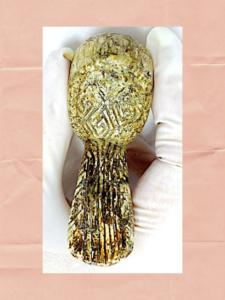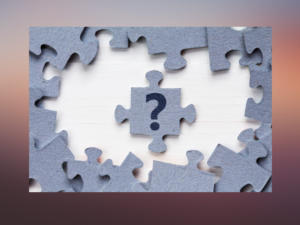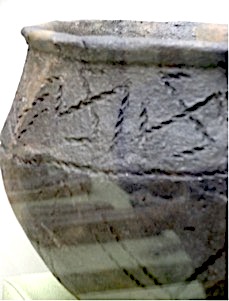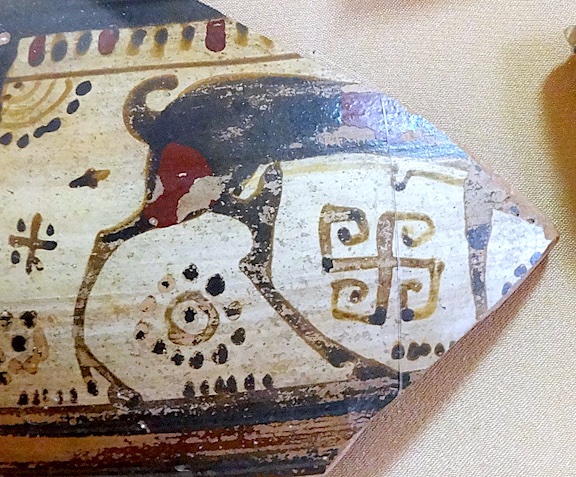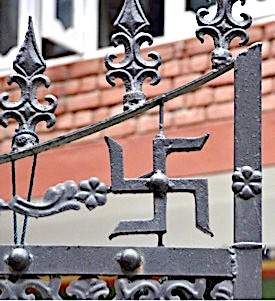When the Ego Destroys the Soul of the Pattern
In decorating, I am most concerned when our ego creates an energy so powerful that it mindlessly muddles a good natural pattern and even reverses the meaning of symbols derived from it. Let’s see, in Patterns and Symbols in Decorating, Lesson VII Part C – the Ego, what an example of such an altered symbol can teach us.
The first we see of a very early version of the symbol is fashioned atop this ivory figurine of a female bird. This fe
rtility symbol, carbon dated at 15,000 BCE, is among the most prized possessions of the National Museum of the History of the Ukraine. The symbol on its back may be the oldest on the planet.
That symbol engraving on the bird turns up in all inhabited continents except parts of Africa and South America. It’s on urns, coins, clothing, vestments, Armenian jewelry, Buddhist temples, Ashanti gold weights, and on 6,000-year-old rock and cave paintings.
The symbol is not humanity’s only ancient symbol. So far, however, it has weathered not just the weather but the terrible destructive power of the human ego. In decorating design, it troubles me how we sometimes let our ego ruin or blind us to good symbols and the natural patterns on which the symbols are based. To defend or glorify our sense of self-worth, we let the ego to reshape good symbols. Our ego has let boxwoods and Greek columns pose for us as symbols, blinding us to the shrubs’ decay and columns’ disarray. It strips us of our acute sensibility to the fragile beauty of natural patterns. We go blind.
What is This Most Cherished Symbol
In the West, that symbol has symbolized good luck. Coca-Cola used it, and Carlsberg incorporated it on their beer bottles. The Boy Scouts used it and the Girl’s Club of America named their magazine after it.
The Navajos integrated the symbol in a healing ceremony known as whirling logs, a sacred geometry homage pulling in the four directions. It has also represented the descent of the Holy Spirit as wind and spirit.
Who could resist this symbol especially when it represented the auspicious footprints of the Buddha. Not I, for one.
That is, until the day I discovered that our ancient, cherished symbol is the swastika.
So Powerful, the Ego
Suffering deep humiliation, Germany’s ego seized upon the swastika symbol. The Western Allies had defeated Germany in the First World War. They extracted draconian reparations, heaving its economy into collapse. Hitler’s keen interest in the occult would have led him to the swastika’s lifeforce legacy. It helped lift the German people’s spirit, but it soon represented Nazism’s evil. From beautiful to loathsome overnight.
We’ll never know the swastika’s origin. Some believe that it originally represented the universe’s spinning constellations at the north pole. It may signify life, love, infinity, fertility, the absolute God, continuing creation, and the vivifying role of the supreme principle of the universe. In the ancient South Asian language of Sanskrit, the swastika symbolizes well-being.
We have no better example of the ego’s stark blindness than the swastika symbol. The ego reversed the symbol’s original meaning. It creates a pull of great negative energy.
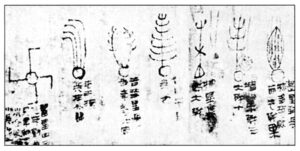
Some feel its symmetry and simplicity justify a belief that it emerged independently in several places around the Northern Hemisphere. The symbol has dominated the earth’s Northern Hemisphere for eons.
Others, like Carl Sagan, suggest that a low-hovering comet with four tails may be its model. He pointed to the pattern woven into an ancient Chinese silk atlas of cometary forms.
Germany now bans any public display of the swastika. It is anathema in the West. Like the lands around Chernobyl, it will be a long time before the symbol can be used again.
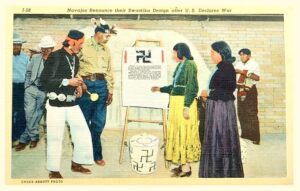
.
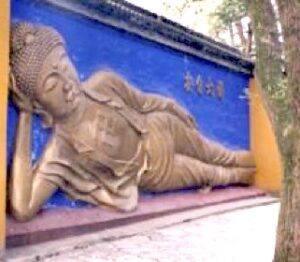
Symbols with Special Patterns
I have found that the most powerful symbols get their energy from the mathematical patterns of nature. The pattern of the five-pointed star, the pentagram, repeats the Golden Ratio in many ways. The pentagram’is a powerful symbol and ego-based institutions often adopt it.
The colored lines in this drawing show some of the many Golden Ratios and Proportions. The ratio of the green to the red line is 1 to 1.6183, the same as the blue to the green and the magenta to the blue.
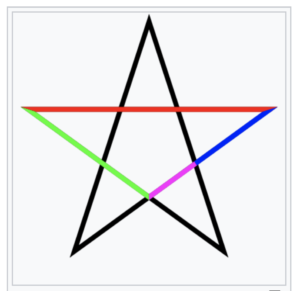
Its oldest use was the symbol of the Order of Pythagoreans in the 6th century BCE. They called the pentagram ὑγιεία Hugieia, “health.” They saw a magical mathematical perfection in it. The form has an incredible array of Golden Mean proportions found in all living creatures.
America’s Founding Fathers adopted the five-pointed star in the country’s flag. It has a mystical history well known to Freemason members, including George Washington and Benjamin Franklin. Today, the five-pointed star is a common Western world ideogram. It has particularly strong associations with the military. The Pentagon, American military headquarters in Virginia built during World War II, is an exact replica of the five sided pentagram.
Fortunately, the five-pointed star has not lost its meaning. Since its subliminal scaffolding is on countless items in nature, it is still part of the teachings of Sacred Geometry.
In Conclusion
So in Patterns and Symbols in Decorating, Lesson VII Parts A, B & C, we have explored the interplay between patterns and symbols.
- We have seen how the ego can fool us into not seeing when a pattern is non-harmonious.
- We have explored an important item in decorating, color, to better understand how to interpret it as a pattern and not a symbol.
- We have looked at how the meaning of a beautiful pattern-based symbol can be changed through the power of the ego.
Now it is important to use these ideas in a practical way. In Patterns and Symbols in Decorating, Lesson VII , D- What to Do, find some practical suggestions.
The History of the Swastika, The Holocaust Encyclopedia
*****
There are two parts to this website, The Lessons, which are more difficult in concept, and the blogs, which are lighter in nature. A blog that you might enjoy with the same theme as Patterns and Symbols in Decorating, Lesson VII, Part B is:
Please note that my website allows you to leave comments at the end of the blogs but not at the end of each lesson. If you have a comment or question about a lesson, you may email me at ruta@rutas-rules.com
